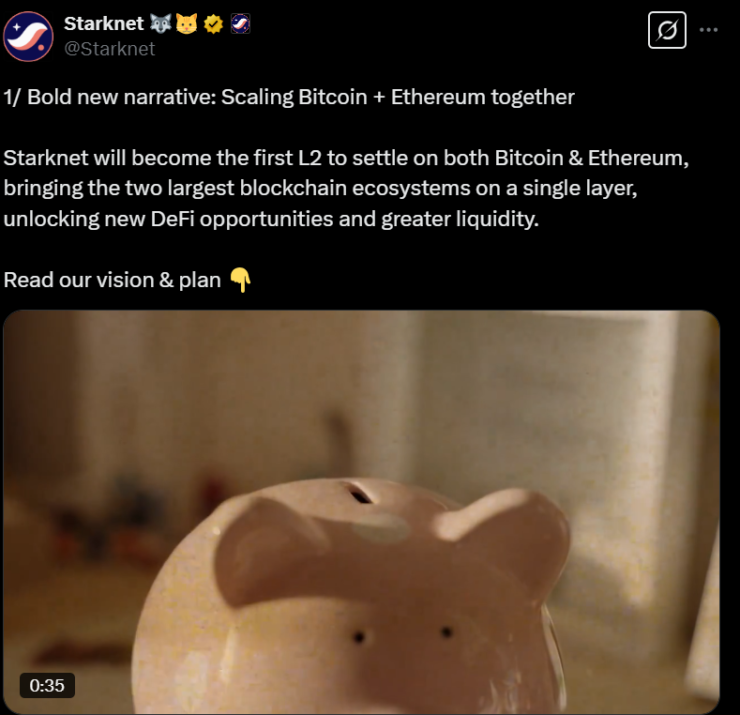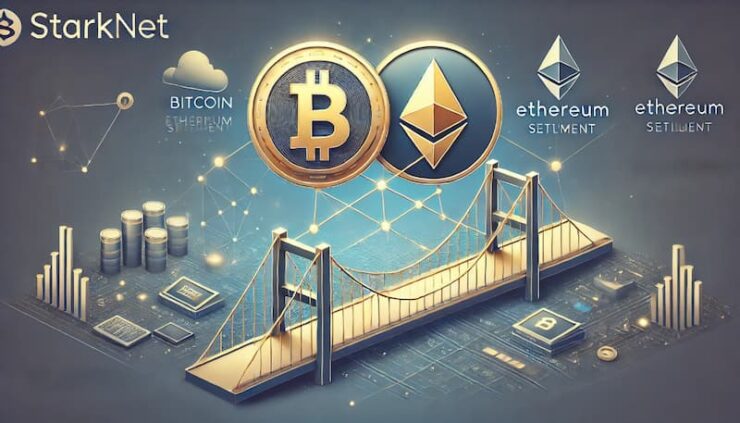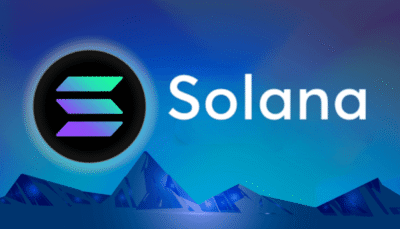The Ethereum Layer 2 scaling solution Starknet is setting the stage for a groundbreaking shift in blockchain interoperability.
In a bold move, the Starknet Foundation has outlined a vision to establish Bitcoin and Ethereum settlements on the same execution layer. This step could redefine how these two dominant networks function.
Bitcoin and Ethereum have long operated as separate entities, each excelling in different aspects—Bitcoin as a store of value and Ethereum as the leader in smart contract capabilities. Starknet aims to change that. The foundation’s recently published Bitcoin roadmap highlights an ambitious goal: making Starknet Bitcoin’s execution layer.
This would scale Bitcoin from its current limit of 13 transactions per second to thousands, significantly reducing congestion and gas fees while enhancing the user experience.
“Most Bitcoin today sits static in wallets and exchanges, constrained by the limitations of the network’s original design,” the Starknet Foundation noted. “There is demand for utilizing Bitcoin for purposes beyond that.”
Reactivating Bitcoin’s Potential
Historically, Bitcoin has been seen as digital gold, a secure but relatively stagnant asset. Starknet’s proposal suggests a future where Bitcoin is not just held, but actively used in decentralized applications (dApps). This integration could unlock staking, lending, borrowing, leveraged trading, and even yield farming on the Bitcoin network—all trustlessly executed via Starknet’s Layer 2 infrastructure.
A crucial part of this plan hinges on OP_CAT, a dormant opcode from Bitcoin’s early days that could enable Starknet settlements directly on Bitcoin. StarkWare CEO Eli Ben Sasson has emphasized that reintroducing OP_CAT would bring native programmability to Bitcoin without compromising security. If successful, this could dramatically expand Bitcoin’s utility while preserving its core principles of decentralization and security.
Institutional Endorsement and Growing Reserves

Starknet’s vision isn’t just theoretical—it’s already gaining institutional traction. StarkWare recently joined the companies allocating treasury funds to Bitcoin, further aligning its interests with the network’s long-term growth. This move underscores Starknet’s confidence in Bitcoin’s future beyond a mere store of value.
In parallel, Starknet is teaming up with Bitcoin Web3 wallet Xverse, which aims to revolutionize how users interact with Bitcoin. Xverse founder and CEO Ken Liao stated that their partnership for Q2 2025 will mark Bitcoin’s “DeFi take-off moment.” The collaboration is designed to move Bitcoin wallets beyond basic storage into fully functional DeFi hubs, enabling seamless interaction with dApps and other decentralized services.
“In today’s environment, there is a temptation for wallet teams to focus only on Bitcoin’s store-of-value function,” Liao explained. “But the long-term future of Bitcoin also includes utility. That’s why Layer 2 solutions must reach the public through the wallets they actually use.”
A Game-Changer for Crypto Payments
Ethereum co-founder Vitalik Buterin has thrown his weight behind a robust Bitcoin Layer 2. During a recent X Space discussion, he said a secure and scalable Bitcoin execution layer could “make crypto payments great again.”
“If you go back to the white paper, Bitcoin was meant to be a peer-to-peer electronic cash system, but Layer 1 is not nearly scalable enough for that,” Buterin noted. He also pointed to the limitations of the Lightning Network, Bitcoin’s current scaling solution, and stressed the need for alternative approaches.
A fully integrated Bitcoin Layer 2 could foster a seamless flow of assets between Bitcoin and Ethereum, streamlining decentralized exchange operations and opening up new cross-chain opportunities. Such advancements could reignite Bitcoin’s original vision, making it a truly global financial system.
The Road Ahead
If Starknet succeeds, this initiative could reshape how Bitcoin is perceived and utilized. No longer just a passive asset, Bitcoin could become a fully integrated part of the DeFi landscape, rivaling Ethereum in dApp activity while retaining its unmatched security and decentralization.
As 2025 approaches, all eyes will be on Starknet, Xverse, and the broader Bitcoin ecosystem. Will this be the moment Bitcoin breaks free from its static role and enters a new era of programmability and scalability? If so, it could mark one of the most significant evolutions in blockchain history.





